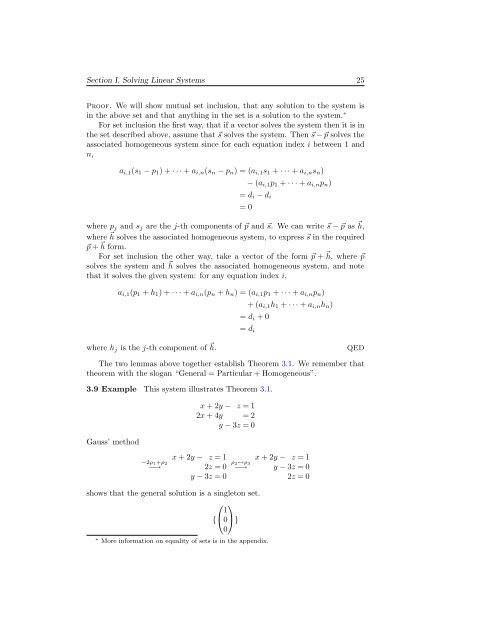24 Chapter One. <strong>Linear</strong> SystemsFor the base step, consider the bottom-most non-‘0 = 0’ equation (the casewhere all the equations are ‘0 = 0’ is trivial). We call that the m-th row:a m,lm x lm + a m,lm +1x lm +1 + · · · + a m,n x n = 0where a m,lm ≠ 0. (The notation here has ‘l’ stand for ‘leading’, so a m,lm means“the coefficient, from the row m of the variable leading row m”.) Either thereare variables in this equation other than the leading one x lm or else there arenot. If there are other variables x lm +1, etc., then they must be free variablesbecause this is the bottom non-‘0 = 0’ row. Move them to the right and divideby a m,lmx lm = (−a m,lm +1/a m,lm )x lm +1 + · · · + (−a m,n /a m,lm )x nto expresses this leading variable in terms of free variables. If there are no freevariables in this equation then x lm = 0 (see the “tricky point” noted followingthis proof).For the inductive step, we assume that for the m-th equation, and for the(m − 1)-th equation, . . . , and for the (m − t)-th equation, we can express theleading variable in terms of free variables (where 0 ≤ t < m). To prove that thesame is true for the next equation up, the (m − (t + 1))-th equation, we takeeach variable that leads in a lower-down equation x lm , . . . , x lm−t and substituteits expression in terms of free variables. The result has the forma m−(t+1),lm−(t+1) x lm−(t+1) + sums of multiples of free variables = 0where a m−(t+1),lm−(t+1) ≠ 0. We move the free variables to the right-hand sideand divide by a m−(t+1),lm−(t+1) , to end with x lm−(t+1) expressed in terms of freevariables.Because we have shown both the base step and the inductive step, by theprinciple of mathematical induction the proposition is true.QED∣We say that the set {c 1β1 ⃗ + · · · + c kβk ⃗ c 1 , . . . , c k ∈ R} is generated by orspanned by the set of vectors { β ⃗ 1 , . . . , β ⃗ k }. There is a tricky point to thisdefinition. If a homogeneous system has a unique solution, the zero vector,then we say the solution set is generated by the empty set of vectors. This fitswith the pattern of the other solution sets: in the proof above the solution set isderived by taking the c’s to be the free variables and if there is a unique solutionthen there are no free variables.This proof incidentally shows, as discussed after Example 2.4, that solutionsets can always be paramatrized using the free variables.The next lemma finishes the proof of Theorem 3.1 by considering the particularsolution part of the solution set’s description.3.8 Lemma For a linear system, where ⃗p is any particular solution, the solutionset equals this set.{⃗p + ⃗ h ∣ ∣ ⃗ h satisfies the associated homogeneous system}
Section I. Solving <strong>Linear</strong> Systems 25Proof. We will show mutual set inclusion, that any solution to the system isin the above set and that anything in the set is a solution to the system. ∗For set inclusion the first way, that if a vector solves the system then it is inthe set described above, assume that ⃗s solves the system. Then ⃗s − ⃗p solves theassociated homogeneous system since for each equation index i between 1 andn,a i,1 (s 1 − p 1 ) + · · · + a i,n (s n − p n ) = (a i,1 s 1 + · · · + a i,n s n )− (a i,1 p 1 + · · · + a i,n p n )= d i − d iwhere p j and s j are the j-th components of ⃗p and ⃗s. We can write ⃗s − ⃗p as ⃗ h,where ⃗ h solves the associated homogeneous system, to express ⃗s in the required⃗p + ⃗ h form.For set inclusion the other way, take a vector of the form ⃗p + ⃗ h, where ⃗psolves the system and ⃗ h solves the associated homogeneous system, and notethat it solves the given system: for any equation index i,= 0a i,1 (p 1 + h 1 ) + · · · + a i,n (p n + h n ) = (a i,1 p 1 + · · · + a i,n p n )+ (a i,1 h 1 + · · · + a i,n h n )= d i + 0= d iwhere h j is the j-th component of ⃗ h.QEDThe two lemmas above together establish Theorem 3.1. We remember thattheorem with the slogan “General = Particular + Homogeneous”.3.9 Example This system illustrates Theorem 3.1.Gauss’ methodx + 2y − z = 12x + 4y = 2y − 3z = 0x + 2y − z = 1−2ρ 1 +ρ 2−→ 2z = 0y − 3z = 0shows that the general solution is a singleton set.⎛ ⎞{ ⎝ 1 0⎠}0∗ More information on equality of sets is in the appendix.x + 2y − z = 1ρ 2 ↔ρ 3−→ y − 3z = 02z = 0
















